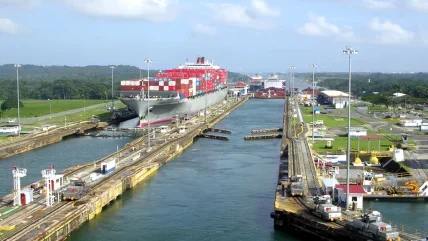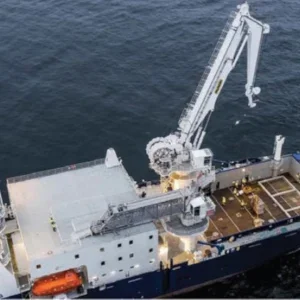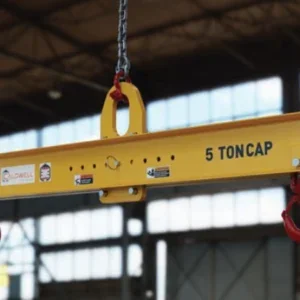
The Panama Canal is one of the two most strategic artificial waterways critical to global maritime trade, the other being the Suez Canal. It is the shortest operative route connecting maritime trade between the Atlantic and Pacific oceans. Before that, the Cape Horn of South America was the only trading route for ships connecting the east and west coast of the Americas, and vessels sailing from Europe to the west coast had to sail around it.
The Panama Canal is essential to global trade, with cargo crosses estimated to be worth over $270bn each year, while it serves more than 140 maritime routes to over 80 countries, according to 2019 Panama Canal Authority stats. Thanks to the 2016 expansion post-Panamax vessels have the capacity to bring larger quantities of cargo into port per visit, which in turn will see an increase in shipping cargo to and from the ports.
According to The Journal of Shipping & Trade July 2021 report, Impact of the Panama Canal Expansion on Latin American & Caribbean Ports, major ports have made huge investments in port expansion and infrastructural development to accommodate New Panamax (neo Panamax) vessels.
US CARGO GROWTH
The widening of the canal and increase in container volumes have provided growth for US cargo and transportation among East and Gulf coast ports, such as New York and New Jersey, Port of Houston, South Carolina Ports, and the Port of Miami.
The journal claims the Panama Canal Expansion has influenced the development of ports within the US, especially on the East Coast, regarding traffic patterns, infrastructural upgrades and intermodal connectivity. The anticipated projection for improvement in the shipping industry on the East Coast and the Gulf of Mexico has increased container throughput growth (TEUs). This growth is because more container ships from Asia will directly access East Coast markets.
For example, The Port of Miami container terminal recently announced plans to R expand its box capacity by one-third, which will be completed by mid-2023 with the delivery of new yard equipment. One of the terminal’s operators, CMA CGM, is helping that growth by introducing a Mediterranean-US Gulf Coast service.
South Florida Container Terminal (SFCT) has ordered 12 electric rubber-tyre gantry cranes (RTGs) from Kalmar that are expected to be delivered by Q2 2023. The cranes are part of a densification project at SFCT that will handle over 500,000 TEU per year, up from its current throughput of 385,000 TEU.
The cranes were part of a deal that SFCT entered in to with the Port of Miami in 2018. At the time, SFCT agreed to give back 20 of the 80 acres it had originally leased from the port so a cruise ship terminal could be built on the land. In return, the Miami-Dade Board of County Commissioners authorised a $42m grant to SFCT for the purchase of the cranes, allowing it to stack boxes higher on the smaller terminal footprint. SFCT says the higher stacking and cranes will enable the yard to handle 33% more containers than before.
SFCT will be handling more volumes after the start of a new trans-Atlantic service from the Mediterranean. The CMA CGM Navegantes made its first call to Miami in October as part of the carrier’s recently announced Med Gulf service. The six-vessel service, which will use ships up to 2,800 TEU, will call at Genoa, Valencia and Morocco’s Tanger Med, a transshipment port for the Indian subcontinent. After its first US call at Miami, it will visit Houston and Mexico’s ports of Altamira and Veracruz.
SFCT is a joint venture of CMA CGM subsidiary Terminal Link and APM Terminals, a subsidiary of A.P. Moller-Maersk. CMA CGM’s Zephyr became the largest containership by cargo capacity to ever transit the Panama Canal in July last year. The neo-Panamax containership Zephyr had a total capacity of 16,285 TEUs. After calling at the US ports of New York and Savannah, it sailed back southbound through the canal, from the Atlantic to the Pacific Ocean, en route to Qingdao, China.
On 1 July, the vessel completed its return trip through the expanded canal’s neo Panamax locks, which opened six years ago to accommodate the world’s growing fleet of large containerships.
While the neo-Panamax locks were initially expected to serve vessels with a maximum of 12,600 TEUs, the Panama Canal team quickly surpassed this threshold, thanks in part to the experience gained operating the locks and its close collaboration with customers.
“There’s no better way to mark the anniversary of the expanded canal than with the Zephyr transit, which exemplifies the continued growth potential that it offers for our clients,” says Ricaurte Vásquez Morales, administrator, Panama Canal.
“At the canal, we are always seeking innovative ways to collaborate with shipping lines to better serve their needs,” says Ilya Espino de Marotta, deputy administrator at the Panama Canal. “This milestone demonstrates the potential that our customers can unlock, thanks in part to our team’s flexibility and willingness to meet new challenges.”
ABB recently partnered with Panama’s Manzanillo International Terminal (MIT) to install its Crane OCR (optical character recognition) technology, including container feature recognition capabilities, on 21 ship-to-shore (STS) cranes. Building on the long-term relationship between ABB and SSA Marine, the contract follows the implementation of ABB Crane OCR at five SSA terminals in the US.
ABB Crane OCR automates the process of recording information of containers loaded and discharged by STS cranes, significantly improving data quality. The availability of centralised data allows planning at the berth and throughout the terminal handling process.
The container feature recognition capabilities leverage the latest artificial intelligence and machine learning technologies to continuously enhance already high read rates.
ABB’s Crane OCR solution for MIT Panama includes OCR hardware and software for container number identification, a multipurpose camera system that detects door direction, bolt seals, hazardous material labels, a damage inspection imaging system, and MatchMaker terminal tractor numbers identification.
ABB’s XClerk Exception Management System will also be implemented, enabling any exceptions to be reviewed and resolved from a remote location.
“We have been relying on ABB technologies and expertise for more than two decades and are happy to continue our mutually beneficial relationship with this OCR implementation,” says Manuel Pinzon, general manager, MIT Panama. “We expect the solution to deliver significant benefits, enabling a safer work environment for our employees, while also increasing operational efficiencies.”
“We are delighted to add OCR to the range of ABB crane equipment at MIT,” says Richard Micheli, product line manager OCR, ABB Marine & Ports. “By adding easy to install and maintain ABB Crane OCR, MIT Panama will improve data quality and enhance container handling productivity to meet the demands of growing container traffic and vessel capacity. Greater efficiency is also one of the keys of safer, greener port operations.”
ABB’s collaboration with MIT Panama on crane automation extends back to 1999 with STS cranes and automatic cantilever stacking cranes, including remote operations in 2010.
To meet demand for its expanding container handling capacity, The Port of Savannah, part of the Georgia Ports Authority (GPA), has ordered seven STS cranes and 15 RTGs from Konecranes. The RTGs will be delivered in August 2023, and the STS cranes arrive in mid-2025.
“The container cranes on order will be key to the GPA handling the increasing volumes and will support continued growth. The seven STS cranes can handle the world’s largest container vessels, with a lifting height of 165ft and an outreach of 230ft. The RTGs will be delivered as fully electric and carbon-neutral, with a lifting capacity of 40 tons,” says Jussi Suhonen, VP, regional sales Americas, Port Solutions, Konecranes.
The STS cranes will be equipped with snag prevention, anti-collision systems and cameras for the operators. They will bring GPA’s fleet of Konecranes STS cranes to a total of 42.
The 15 Konecranes RTGs on order are supplied with cable reel systems for electric operation. They are high performance, 16-wheel RTGs with a stacking height of 1-over-6. They will be equipped with Konecranes’ Active Load Control system, which prevents container sway. They also come with Konecranes’ Truconnect remote monitoring system. When the new RTGs are in service, the GPA will operate a fleet of 225 Konecranes RTGs.
Since 2010, the Port of Houston Authority has been planning the next major channel improvements, working with Congress and the Corps of Engineers. During that time, the growth in the size of vessels increasingly needing to transit the waterway along with the growth in the exports, imports, domestic manufacturing and energy products are creating significant demand and pressure on the Houston Ship Channel and regional infrastructure, driving the need to make improvements.
When complete, the Houston Ship Channel expansion, known as Project 11, will widen the channel by 170 feet along its Galveston Bay reach, from 530ft to 700ft. It will also deepen some upstream segments to 46.5ft, make other safety and efficiency improvements, and create new environmental features.
In June 2022 the Port Commission of the Port of Houston Authority awarded Weeks Marine and Curtin Maritime Corporation contracts totalling $430m to complete the remaining Galveston Bay segments of the Houston Ship Channel Expansion. Weeks Marine will start dredging in Segment 2 (Bayport Ship Channel) in early 2023.
“All of our partners view what some would call problems or challenges as opportunities. Opportunities to drive our industry forward and reimagine how we tackle these challenges in new innovative ways, generating greater results for all,” says Ric Campo, chairman, Port of Houston.
The project kick-off comes as the global supply chain faces unprecedented challenges that have highlighted the importance of ports and also the maritime industry.
To support the Port of Houston’s expansion, as it gets ready to receive larger container ships and higher volumes of container traffic, it has ordered 14 hybrid Konecranes RTGs for its Barbours Cut Container Terminal and 12 hybrid Konecranes RTGs for its Bayport Container Terminal. The cranes are expected to be delivered in the last half of 2023 and continue to mid-2024.
The hybrid Konecranes RTGs on order feature advanced Li-ion battery technology and a battery management system that monitors the charge level and general health of the batteries. The hybrid power system is completely modular and retrofittable. It includes an eco-efficient Tier 4f diesel engine that will charge the batteries when necessary.
“Port Houston is forging ahead in both productivity and container crane eco efficiency. Hybrid Konecranes RTGs have a proven track record, and this new order from Port Houston exemplifies this,” says Jussi Suhonen, VP regional sales, Port Solutions, Konecranes.
The RTGs will have a lifting capacity of 50 tons while stacking containers 1-over-5 high and 6-plus-truck lane wide. They will be equipped with the Active Load Control system. They include Auto steering, Stack Collision Prevention and Truck Lift Prevention.
The port set a new cargo record recently, with tonnage reaching nearly 52 million tons. Previously, the highest total cargo tonnage was 48.2 million tons in 2019.
“Port Houston is not only a port authority – we are also a marine terminal operator of our container facilities. Our long-standing strategy of building capacity in front of demand and investing into our terminals and our people is demonstrating results,” says Roger Guenther, executive director of Port Houston.
Imports are a major driver in this significant growth. In December alone, the port handled 303,204 TEU, a 10% increase compared to the same period the previous year. In this month, 148,301 TEU counted for loaded imports and the remaining 90,660 TEU represented loaded exports.
“We are focused on accelerating expansion of our infrastructure and working with… [our] partners to continue to provide world-class service to our customers and be a major force in the global supply chain,” adds Guenther.
In February, Port Houston’s Bayport Container Terminal welcomed delivery of three neo-Panamax STS cranes.
The ZPMC cranes were manufactured in Shanghai before travelling 15,904 nautical miles onboard the Zhen Hua 25, a large specialised heavy-load carrier vessel, during a 60-day journey to Houston.
“The purchase and installation of these cranes represents a significant infrastructure investment for Port Houston, which will benefit our customers and partners, as well as the Texas economy,” says Guenther
With the arrival of the cranes, the Port of Houston fleet now consists of 28STS cranes and 110RTGs .The latest cranes were the largest ever to be delivered in port Houston history. They stand 158ft under the spreader bar with an outreach of 22 containers wide.
“These cranes are our biggest yet and will facilitate working 15,000 TEU sized vessels anticipated to call our terminals upon completion of the Houston Ship Channel Expansion – Project 11,” adds Guenther.
Recent works at Port Authority of New Jersey New York (PANJNY) include a $1.7bn project to raise the roadway of the Bayonne Bridge to 215ft.
The previous navigational clearance of 151ft only allowed for ships as large as 9,300 TEUs (20ft equivalent units) to pass underneath the Bayonne Bridge. But the new clearance of 215ft provides enough space for newer, larger cargo ships up to 18,000 TEUs to travel under the bridge and access port terminals in Elizabeth and Newark, New Jersey and on Staten Island.
Since the bridge’s navigational clearance was achieved, the Port of New York and New Jersey has seen a dramatic increase in the size of vessels, with more than 26% of all containerised cargo at the port now carried on vessels with the capacity to handle 10,000 or more TEUs, an increase from 4% before the navigational clearance was achieved.
“Deepening our port, expanding our capacity for trade and raising the Bayonne Bridge took years of cooperation between many local, state and federal players,” says US Senator Bob Menendez, who worked with Congressman Sires and the late-Sen. Frank Lautenberg on behalf of the New Jersey delegation to convince President Obama to give the Bayonne Bridge project expedited status. “Today, the Port Authority will tell you that our efforts are already paying off. Record cargo volumes are coming in and out of our port each year. After decades of effort, we have solidified our port as an engine for economic growth and jobs for the region and the nation.”
“If we did not raise the Bayonne Bridge, our ports would no longer be competitive with other ports along the East Coast,” says US Representative Donald Payne Jr. “Our port facilities have experienced unbelievable record cargo growth since the bridge was raised, creating jobs and billions in economic activity.”
In 2016, in partnership with the US Army Corps of Engineers, PANJNY also completed dredging of the navigational channels to and around the Port of New York and New Jersey to 5ft. Since then, its marine terminals have been investing in larger cranes, upgrading infrastructure and adding more heavy cargo handling equipment to accommodate the cargo growth that has accompanied the larger ships that began calling on the port thanks to the raising of the Bayonne Bridge.
And earlier this year, the US Army Corps of Engineers signed off on a report recommending that they, working with the Port Authority of New York and New Jersey, would dredge the navigational channels and the anchorage an additional 5ft in anticipation of even larger ships and to improve efficiency at the port.






